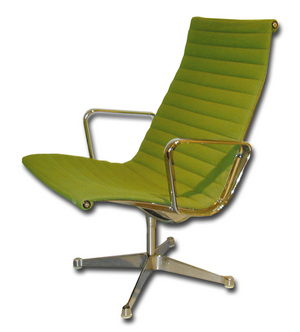The Ducati PaulSmart 1000
Author Archives: Diego Rodriguez
James Dyson on Alec Issigonis
CNN is running a nice piece on Alec Issigonis, father of the (original) Mini. What’s notable about this brief bio is its author, James Dyson, father of the eponymous vacuum that never loses suction.
Issigonis was a genius on many levels. As Dyson notes, the father of the Mini was nothing if not elegant in both his design solutions and his structured approach to problem solving:
Sir Alec Issigonis… came up with his
ingenious idea while sipping on a gin in a hotel in Cannes — a very
civilized approach to engineering.
If this article is indeed written by Dyson and not some pathetic PR flak, it poses an interesting question: why not have real, working designers write the history of design? Why leave it up to non-pracitioners who don’t know really understand the design process? I’d like to see more designers follow Dyson’s lead. Gin or no gin.
metacool Thought of the Day
"We used to bring a piece of furniture we were working on home to look at it, because at the office everything was out of scale." – Ray Eames
[You’ve got to get out and see how your offerings work in context. Needs are verbs, and your end users probably don’t speak the same language you do. Get out and see, hear, listen.]
See you at BloggerCon III
I’m stoked to be attending BloggerCon III tomorrow. If you’ll be there and would like to meet in person, drop me a line.
Building Marketing into Your Offering
Change This is passing the 100k mark for manifesto downloads from their site, and reckons that if you add in pass alongs enabled by the "smoothness" features built in to those manifestos, the total number is more like 250k. Since August.
Wow.
This is proof that, at least in the case of fostering word of mouth on the internet, if you’re smart about building in smoothness and pass along functionality, people will spread your stuff. In addition to designing the tools correctly, Change This set up the human incentives right, too — they enlisted blogging mavens and connectors (including yrs trly) to host manifestos, and rewarded those uber bloggers with increased traffic and prestige.
Apple, could you design a simple voting process for us?
 What’s that sound? Oh, it’s just my hand patting myself on the back.
What’s that sound? Oh, it’s just my hand patting myself on the back.
But seriously, folks, I just voted, and what I saw, heard and experienced scared the bejeezus out of me. I’m talking about the electronic, touchscreen voting booth which I just used to decide the fate of the planet. So many aspects of the design sucked, it’s hard to know where to start. Here are the problems I had:
1) I was issued a magnetic card “key” to allow me to use the voting machine. It fit into a slot on the front of the voting machine. I expected the machine to grab the card upon insertion and pull it in, much like an ATM machine would (as a society, we’ve been trained to have cards sucked in). But it didn’t. My card just sat there, limp and inert. Finally, my inner mechanical engineer spoke up and I rammed the card home. Bling bling! The touch screen awoke and I could now do my civic duty.
2) Each screen had two or more votable items displayed at a time, which a big yellow “next screen” arrow in the lower right. Thing is, I was able to press the yellow arrow and skip a votable item without the system giving me any feedback that I had skipped an item. Folks, the self-serve kiosks at United Airlines work better than this. Lucky for me I’m a software industry veteran and was able to go back a page. But what if I was an “analog”, part of the population who has never used a computer, let alone a web browser-style interface? What if, for example, I was an 80+ year-old woman wearing those big wraparound sunglasses and trying to vote with this damned thing?
And there she was: next to me an elderly woman sat there trying to stick her card in for about 45 seconds. She muttered and cursed and finally called an attendant for help.
Then there was the elderly gentleman on the other side of me. He stood there motionless the entire time I was voting, and then asked the attendant for help. Seems he couldn’t find his candidate on the touchscreen (video monitors are hard to read — we read better on paper). It took a while for the local “IT department” to sort of his problem. The answer? The poor guy was trying to vote for “Laura Magenta”, one of the sample candidates from the paper instructions he had in his hand. It wasn’t his fault. Just a stupid, poorly-conceived and implemented voting process.
God help this country of mine. Or better yet, get Steve Jobs and crew to design a simple, effective voting process for us.
Simplicity that Works
Trick or treat!
Several dozen kids yelled that at my front door this Halloween evening, but for most of the night I felt like my new IBM T42 ThinkPad was also shouting the same thing. Why? Because I spent over two hours trying to get this brand new computer to stop:
1) Crashing every 5 minutes
2) Losing its connection to my home wireless network every 30 seconds
IBM Trick No. 1: As of last week I used another ThinkPad with the same operating system (XP), and it had no problems working with my network
IBM Trick No. 2: When I called IBM ThinkPad support, they said, and I quote this verbatim: "We only make the computer part, we can’t help you with the software stuff." What an incredibly poor response, one that betrays a lack of understanding of the business they’re in. What I need from from IBM is a total solution — if I wanted to spend a perfectly beautiful California evening hacking on a crappy PC, I would have bought some no-name brand, and not spent a premium for a ThinkPad. IBM seems to be competing with Handspring for the worst customer service on the planet, but that’s a story for another time.
Treat: this week’s Economist has a special section on IT complexity, which made me feel feel better about the fact that my new PC has worse manners than a new puppy — everyone has the same problems with this horribly complex technology.
What I want is simple: simplicity that works. A few months ago in this blog I touched on the theme of simplicity; I’m looking forward to revisiting it over the next week.
Unabashed Gearhead Gnarlyness
Intrinsic Motivation
Seth Godin has an interesting post today concerning six, lobsters and videotape:
Today, in anticipation of a dinner party, I stopped at a lobster seller in Chelsea Market in NYC. I asked for a six pound lobster. The pricing at the store is $9.95 a pound for small lobsters and $8.95 a pound for lobsters six pounds and up.
The lobster weighed (I’m not making this up), 5.97 pounds. For reference, that’s just less than a pound by the weight of a penny. Feed the lobster a plankton and it would be six pounds.
He started to ring me up at $9.95 a pound. I pointed out the price breakdown and the guy shrugged and said, “It doesn’t weight six pounds.”
Two co-workers came over and with precisely the same uncomprehending grin, repeated his point. I added a penny to the scale but they weren’t swayed.
So, the two questions are, “Do you think the owner wanted them to act this way?” and “Would they have acted differently if they were on camera?”
I believe that the best motivation is self-motivation. That teaching people the right thing to do is far more effective than intimidating them into acting out of fear.
Seth brings up the critical difference between intrinsic and extrinsic motivation: if you can create a culture that encourages people to act on the basis of self-motivation, you’re likely to have good relations between workers, good customer service, and best of all, a place that churns out innovation. Why? Because intrinsic motivation leads to enjoyment, flow and meaning. Ask Honda or Cox.
It’s Cool to be Keen
Keen shoes have tipped. In a repeat of the Doc Martens phenomenon of the late 80’s, we’re going to start seeing them everywhere, on everyone. The thing about a pair of Keen shoes is that you can’t help but notice them when they stroll by — their designers took a risk and added a big old ugly toe-protecting bumper to the front of the tried-and-true Teva, and came up with something which screams "Look! I’m different and kind of cool." That toe bumper may be ugly, but it represents Keen’s entire "brand", and no amount of money thrown away on awareness building could come even close to the word of mouth (message of foot?) buzz generated by this aesthetic oddity. Now, I’m a TiVo guy, so I don’t watch many commercials, but to the best of my knowledge Keen doesn’t spend anything on advertising. I saw my first pair at REI, then I saw another set on the toes of a friend… and… and I had to have a pair.
The lesson here is to build your marketing into your offering. Make something great, something interesting, and make sure that you design that offering such that private usage is made unavoidably public.
Keen. All the cool kids are wearing them.


